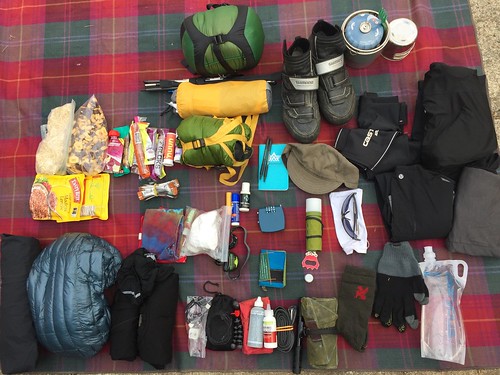
(Photos © J. Maus/BikePortland)
I had no idea what to expect before riding 505 miles in three days on the Oregon Outback last month. What I did know is that whatever happened, I’d count on my gear to help get me through it.
I also knew that if the ride wasn’t destined to go well, I hoped it’d be due to things (mostly) out of my control — like mechanical or physical mishaps, crazy weather, route problems, and so on. Thank goodness I was lucky. Pretty much everything went smoothly. I was also very fortunate to have used excellent gear that I can now confidently recommend if you are headed out on an adventure of your own.
Below are a few photos and my thoughts on the gear that helped get me through the Outback — from the first mile to the last — with a smile on my face…
Bikes have always been a motivator for me. When I was 18 (in 1993) I bought a GT Zaskar. It had XT components and was nearly $2,000 (a lot of money, especially for an teenager). It was a racing bike and I figured I would be a poser if I didn’t actually race on it. So I did. And it changed my life.
Fast forward 22 years and another bike had a similar effect. Once I got a bike set up specifically for adventure riding and bikepacking, there was no turning back. There were be no more excuses for not getting out there and trying big rides like the Outback.
Here in Portland we’re lucky to live in one of the healthiest bikepacking ecosystems anywhere. Part of that ecosystem is the growing number of shops with real expertise in setting bikes up for adventure. 21st Avenue Bicycles is one of them. I had been an admirer of their custom builds for a while and heard the buzz that they were bikepacking-friendly. Turns out it was all true and they’re a great shop to work with. They listened to what I needed and set me up with one of the most versatile, dependable, tried-and-true adventure bikes on the market: the Vaya by Salsa Cycles.
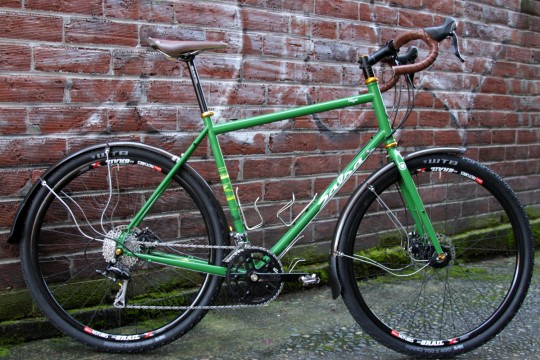
(Photo by 21st Avenue Bicycles)
The Vaya they built up for me is far from stock. Shop manager Nick Wood and his crew put together an intelligent build that includes: Shimano 2×10 drivetrain with 105 shifters and derailleurs; White Industries VBC crankset; Stan’s Grail tubeless rims with WTB Nano 40c tires; XT rear hub and Alfine 501 dynamo front hub; Chris King headset (with matching gold seat collar and skewers from Salsa); Jagwire sealed shifter/cable housing; King Cage bottle cages; Brooks Cambium saddle; Avid BB7 brakes; and Salsa Cowbell bar/stem.
On the road or off it, the bike rides great. It’s one of the most comfortable bikes I’ve ever owned. I can (and did!) ride it all day and night. The wide bars give me plenty of hand position choices and the the 40c tires give me a lot of confidence on the rocks and downhills (maybe too much confidence, since I’ve already flatted both tires after hitting rocks at high speeds). My favorite thing about the bike is that it can handle rough roads but it doesn’t sacrifice too much on the pavement. My riding is usually 50-50 pavement-gravel/dirt and the Vaya behaves equally well in both environments. Follow along on all our adventures together here. — Salsa Cycles Vaya
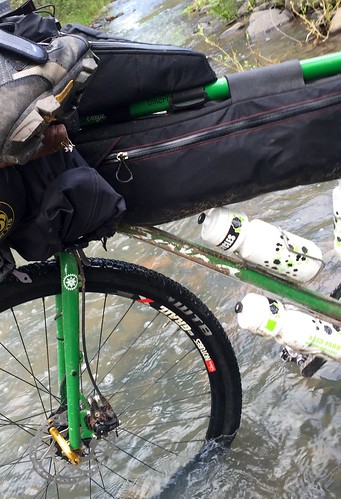
unseasonably high stream in the Ochoco National Forest.
I’ve always been a rack-and-pannier guy and I’m new to the frame-bag thing. Now I’m kicking myself for not getting these sooner. Revelate bags are so efficient: They set up tight to the bike and carry a surprising amount of stuff.
You know how some people say you can judge the quality of a car by slamming a door and listening to the sound it makes? When I yank on the zipper of these Revelate bags, they just sound well-made. They’re tough (fabric is thick in all the right places), waterproof, and have all the little built-in features that make life on the road easier. What I really like are all the cinch straps and buckles that allow me to keep them snug (I abhor floppiness).
I have a special place in my heart for the Feedbag. I used one of these on each side of my stem: one for my phone (which was also my camera/GPS device/route map so it needed to be easily accessible) and small food items, the other for a water bottle. — RevelateDesigns.com
Lightweight sleeping gear is a must if you want to make lots of miles in the backcountry. My one night of real slumber on the Outback was crucial because it prepared me for two days where I rode 365 miles and tallied about 23,000 feet of climbing.
To get the right gear I turned to Mountain Shop in the Hollywood neighborhood. Not only are they the oldest outdoor shop in Portland but they are committed to bikepacking: They have an entire studio devoted to sales and rentals of adventure bikes. When I told store manager Guy Trombley what I needed (and that I was a novice on the topic), he took me through everything and had spot-on recommendations…
Exped Synmat UL 7 sleeping mat ($149)
This mat is comfortable, light, it packs small, and it’s super easy to inflate and deflate. What else is there to say? — Exped
Flicker 20 UL Quilt Bag – Feathered Friends ($359)
Feathered Friends is a small, Seattle-based company known for its high-quality down sleeping bags. The model I used, the Flicker, is actually a quilt that opens up flat so I can use it as a blanket or a bag. The 900+ goose down has excellent loft and warmth that compresses down to about 7 x 10 inches and it weighs just under two pounds. The zipper is top-notch and I loved the cinches at the top that allowed me to snuggle in when it got chilly. — Feathered Friends
Advertisement
Skyscape Trekker tent by Six Moon Designs 24 oz ($235)
Six Moon Designs is a Beaverton-based company (!) that was recommended to me by the staff at Mountain Shop. I was initially interested in their single-pole Lunar Solo model, but opted for the Skyscape Trekker because it weighs the same and has more features. At just 24 ounces, this tent packs a lot of function into a small package. I love that it has two entry doors (so I don’t have to crawl over all my stuff to get out) and I found it very straightforward to put up. I sealed the seams, so the silicon nylon outer shell did just fine with a bit of overnight drizzle and rain. — Six Moon Designs
Rapha Touring Shorts ($125)
My friend at Rapha calls these his “modesty shorts.” I get the modesty thing, but I also prefer to wear shorts over my tight spandex because it helps me look more like a normal person when I’m out in the country. These shorts worked perfectly. They’re snug fitting (like all Rapha stuff) and have a minimalist design. If you want big pockets, look elsewhere. These shorts have just two, small (zippered) pockets — one in front and one in back. Smooth and silky fabric on the leg cuffs allowed the shorts to roll over my thighs without chafing or rubbing. — Rapha
Mountain Hardwear Ghost Whisperer Jacket ($320)
I was probably one of the last Portland bike enthusiasts without a down jacket. It just seemed like such an extravagance! I finally caved because for bikepacking it’s really hard to beat the warmth and packability of down. The Ghost Whisperer weighs just 7 ounces. I didn’t pack a long-sleeve shirt, baselayer or sweatshirt, so this jacket really came in handy while riding in cool moonlit air in the wee hours of the morning. — Mountain Hardwear
Acre Meridian Waterproof Jacket ($455)
This is the best performing — and best looking — rain jacket I’ve ever owned (it’s also the most expensive). With the unexpected amount of rain we got, I was very fortunate to have this along for the ride. Acre (a division of Mission Workshop) has really raised the bar. The cut is snug without being restrictive. The Polartec NeoShell fabric stretches ever so slightly and somehow it’s breathable and waterproof (I know, that isn’t supposed to be possible). I rode about 100 miles in the rain with this thing on and when it was really pouring, I pulled the hood over my helmet. Then, when I didn’t need the hood, I just reached around and unsnapped it without even getting off my bike. The zips in the sleeves are in just the right spot where I could open or close them with one hand. The one odd thing about this jacket are the front pockets. They’re there, but not really large enough to fit your hands in.
What really impresses me about this jacket is that I can wear it with confidence in the demanding conditions of the Oregon Outback, and I can also wear it to work with a nice pair of pants. — Acre Supply
Cliff Shot Bloks ($2 per pack)
I’m not one for high-tech food but these little “energy chews” were one of my go-to sources for on-the-bike nourishment (along with trail mix). I have had muscle cramping issues throughout my years of riding, but I didn’t cramp up once on the Outback. Whether related or not, I now swear by Shot Bloks. They’re easy to eat, taste great (better than Gummi Bears!), and have caffeine, potassium, and electrolytes. — Clif Bar
Outdoor Tech Buckshot All-in-One Wireless Speaker/Power Bank/Flashlight ($79.95)
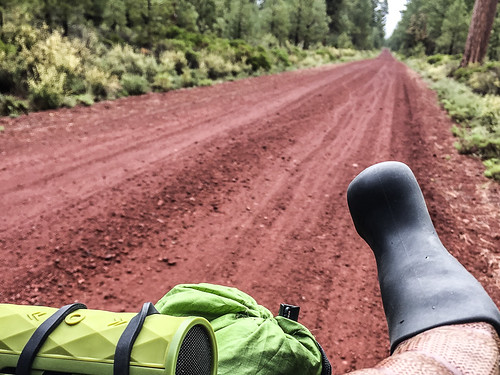
This do-it-all device was one of the pleasant surprises of my trip. On lonely and deserted backroads, the Buckshot’s speaker helped me keep my rhythm and sanity. When I flatted at 10:00 at night, the glowing lamp and flashlight functions made my repair work much easier. When I needed a little power boost for my phone, I just plugged it right in. All that functionality comes in a small, water and shock-resistant package that attached easily to my bike with the included rubber strap. This thing works great. It connects to my phone via Bluetooth and the battery has still never worn out on me. It’s also been fun to use while cruising around town on the weekends with my family. — Outdoor Tech
Sinewave Cycles Reactor ($220)
It was a huge relief to not worry about power or recharging my devices once this entire trip. One big reason for that is because I had a Reactor USB port by Sinewave Cycles in my stem cap that gave me reliable charging all day long (I also had an external battery and my Buckshot speaker which doubles as a power source). The guys at 21st Avenue Cycles hooked it up to my front dynamo hub and it worked as advertised. One caveat is that I had to be going over 12 mph or so for the charge to really get going. — Sinewave
I hope these gear recommendations are helpful. And thanks to all the companies that supported my trip. It would not have gone as smoothly without your help!
I’m happy to answer questions about them, and I’d love to hear your bikepacking product recommendations in the comments section.



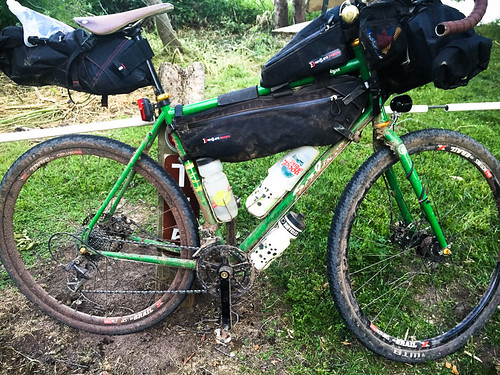
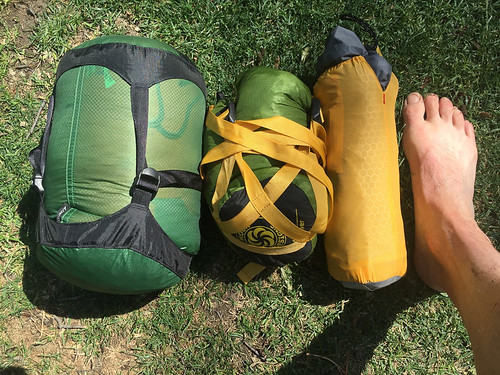
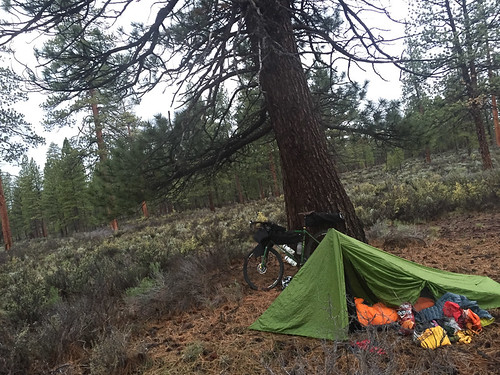
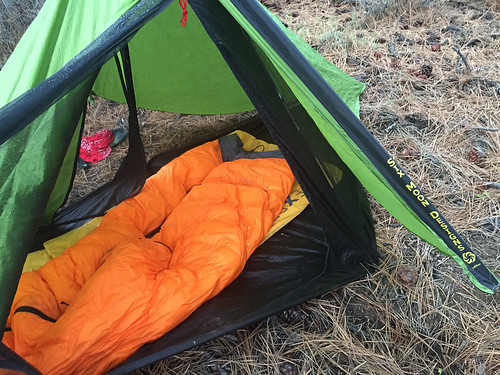
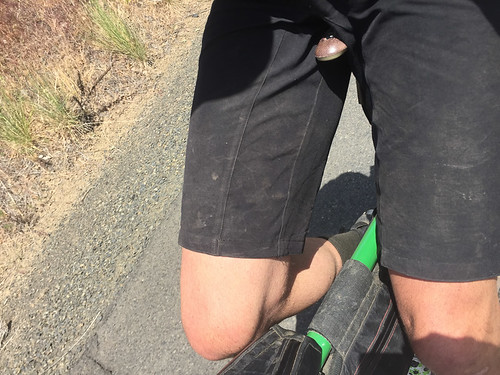
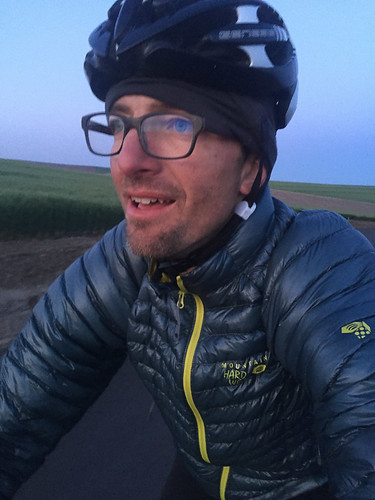
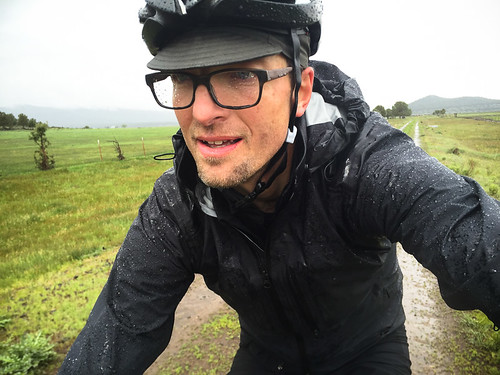
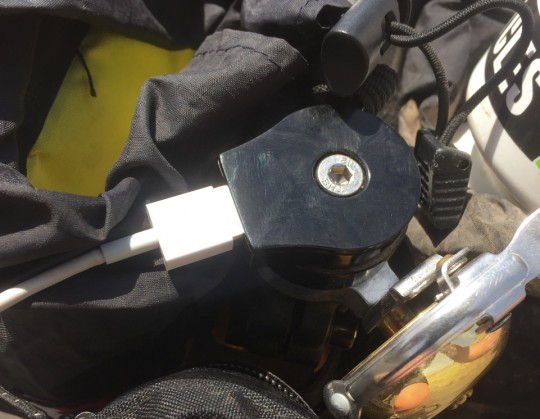
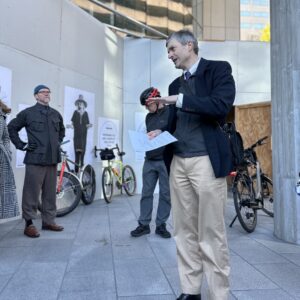
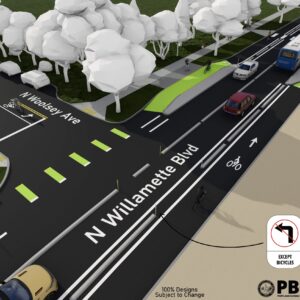
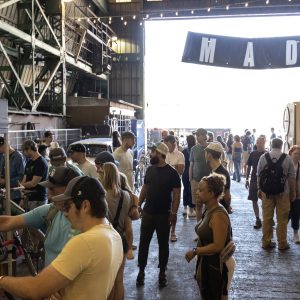

Thanks for reading.
BikePortland has served this community with independent community journalism since 2005. We rely on subscriptions from readers like you to survive. Your financial support is vital in keeping this valuable resource alive and well.
Please subscribe today to strengthen and expand our work.
I love my down jacket! it makes a great pillow unless I need to wear it on the coldest nights.
That doesn’t look very many calories. Is that really all the food you took?
That’s all the food I left with.. But I bought food along the way too! At a market in Silver Lake and in Prineville.
That makes more sense now 🙂
Fun. How things have changed!
I’m curious how much all the gear weighed?
Here’s an interesting site by a very opinionated if also knowledgeable Oregonian, Robert Beckman, who has become obsessed with reducing weight on his bike tours:
http://robertbeckmandesigns.net/advanced_index.php
ditch the tent and try a hammock and tarp next time. no pad needed. in the summer you might not even need the tarp. of course you might have to get creative with straps/attachment points.
ENO makes a huge selection of stuff..
Nice…what a great way to spend a few days. I am quite jealous…actually very jealous. Well done! Yep, still extremely jealous.
Thanks for doing this post! I don’t have much of an interest in bikepacking, but I’m definitely a gear nerd and love reading reviews about tech wear and bike accessories!
I believe Six Moon Designs is in Beaverton! I used one of their first tent designs, the Europa, on a thru hike of the John Muir Trail in 2004. I don’t own the tent anymore. I gifted it to a friend, but he still uses it and it’s held up great!
I want to know where you’re hiding all the Slim Jims and the Cheetos. 😉 Such a practical tiny green tent! Want!
A really interesting summary, thank you. Did you have your dynamo set up to charge your phone etc? (And if so, how!)
Yes I did Moleskin. I just added a photo and a link to the Reactor by Sinewave. It’s an awesome product that connects through my stem down to the dynamo hub and has a nice little USB port right in the stem cap. I used it to charge my speaker and my phone during the day.
Recommendations for people that don’t have a ton of money:
– Next Adventure, especially the basement
– REI used gear sale
– Columbia Employee Store or Outlet Store (they sell Mountain Hardwear)
– Craigslist
You can put together a similar gear list for much less. Don’t let the quoted prices scare you away from Bikepacking.
Agreed about budget-conscious bikepacking! Although the stuff listed above is all excellent, you can still get very high-function gear (modestly heavier, of course) for about half the price, and with a little extra weight you can pay significantly less yet than that.
I’m really tempted by the Buckshot Pro for a weeklong tour I’m planning for August in the woods of Minnesota and Wisconsin, where I now live. I currently use a tiny AA-powered speaker that plugs into my iPod, but the multifunctionality of this item is tempting. I’m also hoping to have my dynamo upgrade complete by then, but I still can’t justify the Sinewave when I already have a rechargeable and far less expensive battery pack that can refill my phone several times.
By the way, if you have much of the sleeping/camping gear already but not the bucks for the fancy bike bags, you can still do just fine with a rack and pannier(s). Frame bags and large under-saddle bags have revolutionized bikepacking without question, but their capacity is limited for shorter folks like me (riding a 29″er!) with smaller frame triangles and less saddle-to-tire clearance
The old way still works if you don’t mind the 2-4 extra pounds. Just get a *GOOD* rack made of steel, and bring extra attachment hardware just in case: I’ve had a decent-quality aluminum rack fail due to fatigue during a tour, and I’ve had failures of the brackets and whatnot that hold the rack onto the bike.
Also, the biggest revelation from my most recent tour (5 days around Eastern Oregon’s Strawberry and Blue Mountains last September) was how great it was to have all my snacks, maps, etc. accessible from the handlebars. I now swear by Feed Bags plus a good handlebar bag. It is SO nice not to have to stop to keep the calories coming in or double-check a waypoint.
http://www.oregonbikepacking.com/the-death-of-the-oregon-outback/
What’s the best brand of toilet paper to bring on the Oregon Outback? Do you have a suggestion for a brand of artisianal small shovel to bury feces?
Great reviews, thanks so much for putting this post together! Need to start saving up now.
I have been looking at building up a gear set up for touring/bike packing over the last couple of summers. Buying one item here and there for a camping trip or family outing has worked well. One thing that I have had a hard time finding is tents without poles or with short poles that fits well in a bike bag. Anyone have a list of packable tents?
Stephen, I used a Tarptent ProTrail. Very lightweight and you can order poles with the tent that fold down very short. I stored them in my frame bag on the Outback and my tent and sleeping bag in my handle bar bag.
Steven last year I used my ancient, I mean venerable Bibler bivy sack in conjunction with a NeoAir pad ($$$ but worth it) and a 46 * down bag and I slept like a baby every night. A bivy may be a little claustrophobic for some people but it’s been my setup since the 90’s to include winter camping in Alaska. I value simplicity over maximum comfort.
this is the sort of gear review i feel i can trust. you enjoyed some type II fun, documented the adventure, and then, later on, posted your opinions.
sorry if i missed it, was any of the gear/clothing sponsor donated?
the ride report for the oregon outback was also much appreciated as it’s something i’ve never done and maybe won’t ever get to do
Hi ac,
Good question. All of this gear was either part of a promotional partnership agreement or given to me at no charge by the manufacturers.
I’m glad you got to go on the Outback. Unfortunately, this was the last Oregon Outback. Some people just can’t have nice things. I really want these people to come forward for public shaming.
http://www.oregonbikepacking.com/the-death-of-the-oregon-outback/
This was the last unsanctioned event. The route still exists and I believe individuals should go out and ride it. The only way to rebuild trust with the people who live in Silver Lake and other areas is to show that we are not like the minority who chose to act in the way that they did.
Wow, that is unbelievably sad. Sure doesn’t help close the urban-rural divide in Oregon. I do hope trust can be rebuilt by solo and small-group riders with more respect.
Seriously, what is wrong with people?! I see the same type of things when I am out in the woods. Hard to fathom how people think this behavior is a-ok.
Unfortunately, this is the problem with sanctioned, unsupported rides. You take a bunch of noobs and send them out into the woods, and stuff like this is going to happen.
This is nothing new. I’ve stumbled across sites like this numerous times while backpacking in Oregon. The problem with the Outback ride is that it is not just in the wilderness. Misbehavior impacts the people that live along the route.
Nick at 21st Ave Bikes was great when he helped me buy my first real city bike a couple years ago… loving my Raleigh Alley Way…
I was afraid to add up all those $’s. On top of a specially purposed bike, the cost could be scary. But, maybe that’s the draw. You spend all this money, then you BETTER DAMN TAKE A TRIP!
The best thing about most “bikepacking” bikes is that they make for good commuting / touring / etc bikes. Or use your commuter and modify it. No reason a relatively inexpensive bike can’t make a trip like this. The most important thing is to get out and go. (As long as you practice Leave No Trace ethics.)
What size chain rings? Was front shifting compromised at all?
Just a note that Six Moons Designs is in Beaverton, OR not Seattle. I used one of his tents on the Southern Tier and loved it!
Poor choice of words calling it a race in the headline, but it seems the event has been cancelled going forward.
http://gearjunkie.com/oregon-outback-bike-race-canceled
Is that really all the food you took?
Yeah. That’s all I took in my saddle bags. I stopped at one store along the way and had bought a big meal in Prineville.